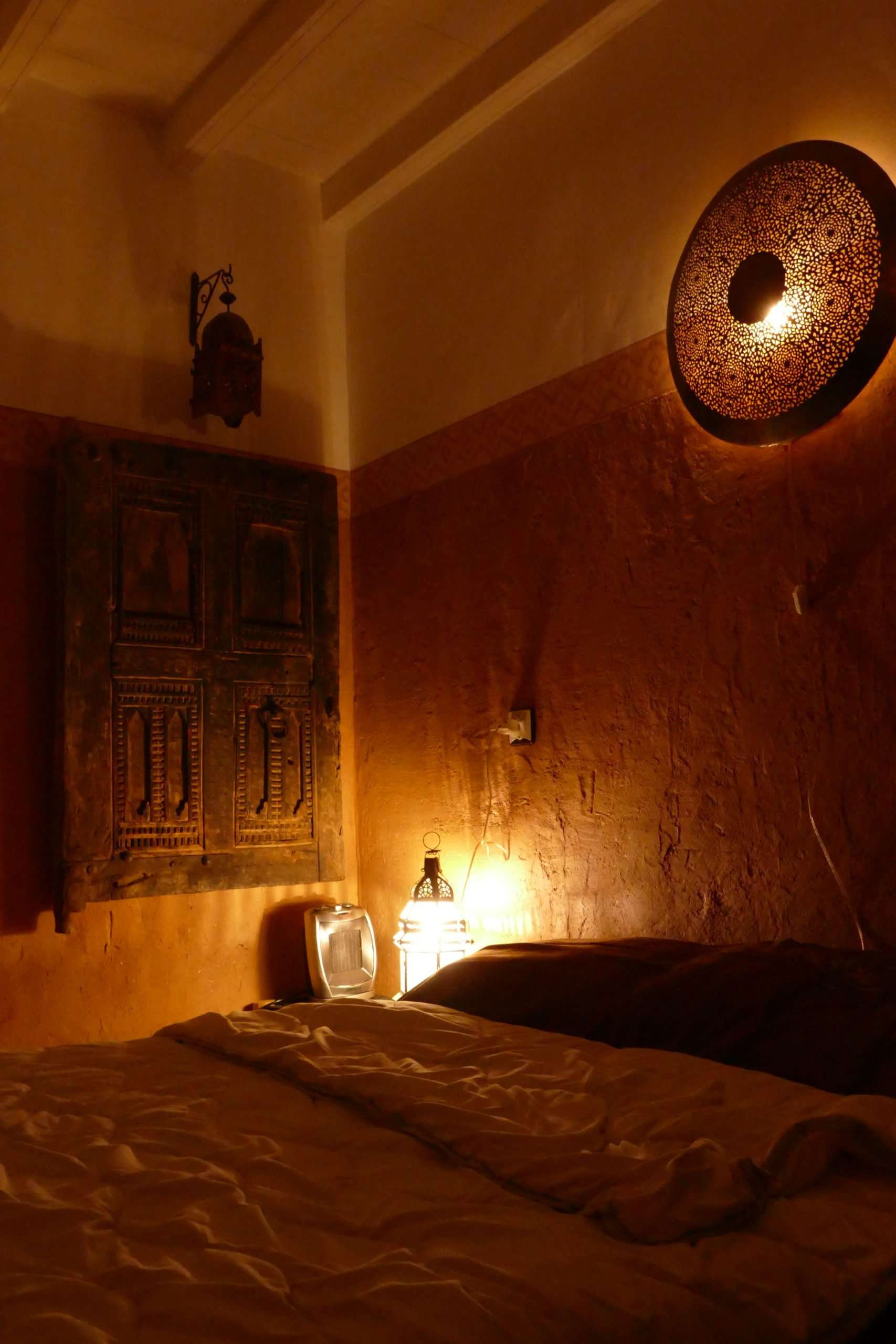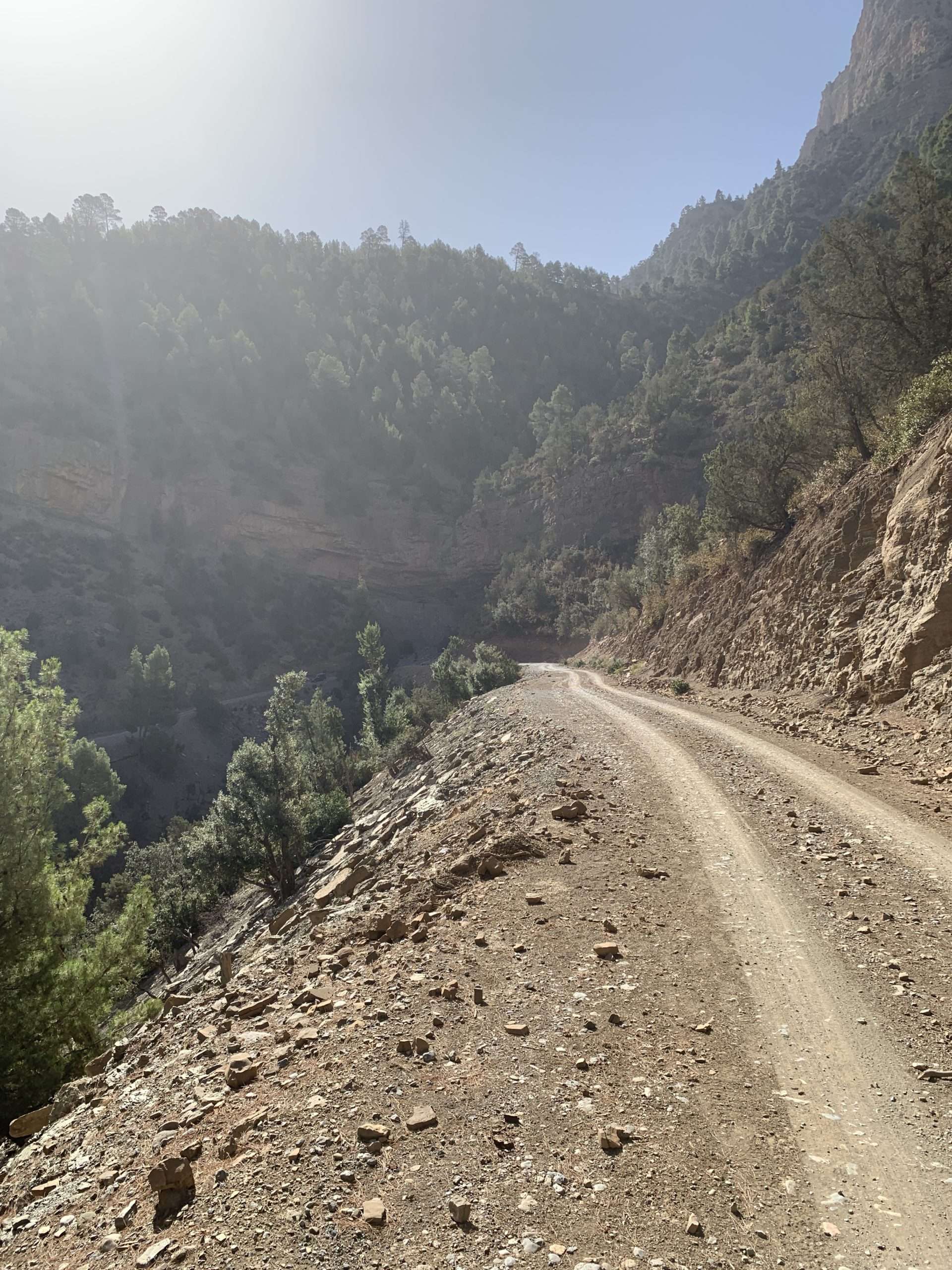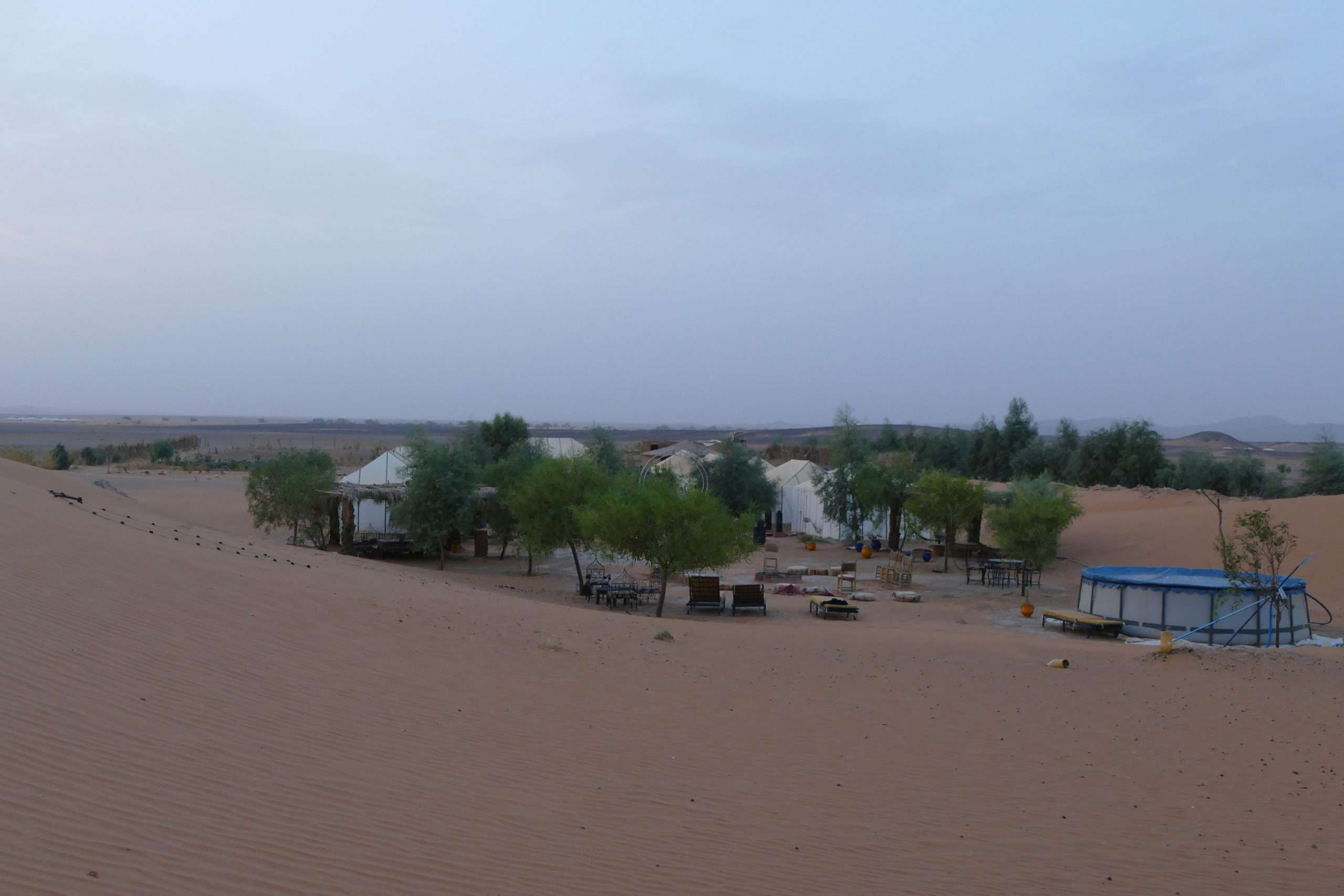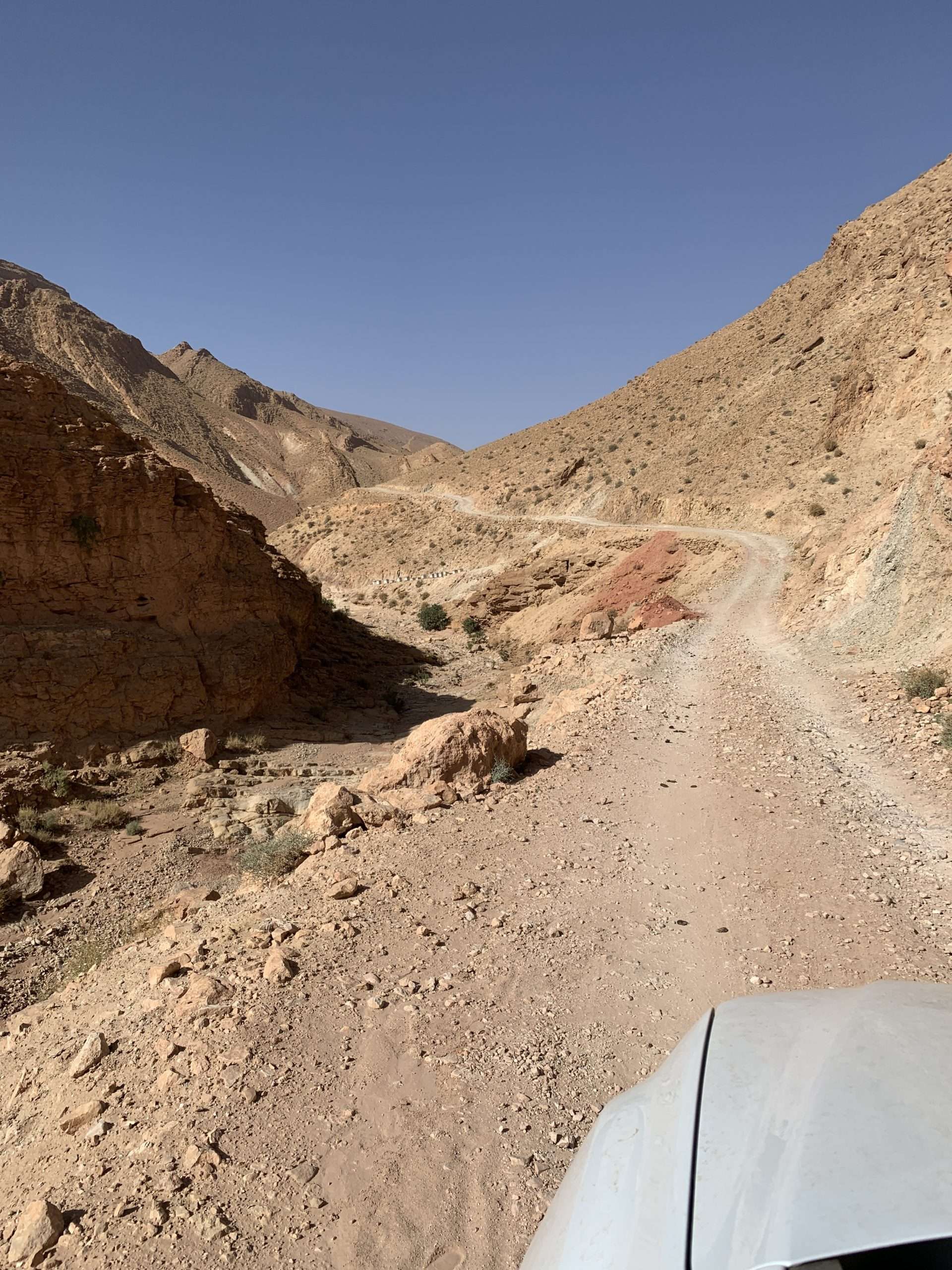14-day route
The route took 14 days: we arrived in Marrakesh on the night of 1 August and flew back from Marrakesh on the night of 14 August. At the bottom of the page you can download a file with the detailed trip plan with information of all the places where we slept.
Day 1-2: Marrakesh
We arrived in Marrakesh on the evening of the 1st and explored the Medina on the 2nd. We slept two nights in a riad near Jamaa Al Fna square. Below is a map and description of the route



Marrakesh Medina in 1 day
- Bab Agnou Gate: Gate dating from the 12th century. It was one of the 19 main entrances of the wall surrounding the Medina.
- Saadian Tombs: Sultan Ahmad al-Mansur and his family are buried here. Its great jewel is the mausoleum of the Hall of the Twelve Columns.
- Bahia Palace: Built in the late 19th century to become the largest palace of all time.
- Dar Si Said Museum: It has the most complete collection of objects in the city.
- Jamaa el Fna Square: It's worth stopping by during the day (delicious juices) and in the evening.
- Lunch at “Dar Cherifa"
- Souks: Alleyways area with interesting souks (bazaars): 1) The dyers' souk with sun-dried coloured wool 2) Rahba Kedima Square with stalls of medicinal herbs, fabrics, basketry and spices 3) Kissaria Serrajine with babouches and silk garments 4) Tillis with carpets 5) s-Seffarine with cauldrons 6) and Nejjarine with wooden articles.
- Medresa Ben Youssef: The largest Muslim school in Morocco dating from the 14th century, which impresses with the decoration of its central courtyard, arches and walls.
- Koutoubia Mosque: The most important in the city and one of the largest in the country with a 66-metre high minaret.
- Jamaa el Fna Square: Enjoy the sunset on a terrace where you can watch the Jamaa el Fna Square transform as the minutes pass and the sun goes down, filling up with food stalls as the evening approaches. Dine on delicious meat kebabs


Day 3: Ouzoud Falls- Aït Bouguemez Valley
We picked up the Dacia Duster to visit the province of Azilal and drove 3 hours to the impressive Ouzoud waterfalls: at 110 metres the second highest in Africa. We bathed, and shared peanuts with the local monkeys. In the afternoon, 2 hours to reach Tamazight territory in the central High Atlas: the isolated Happy Valley (Aït Bougoumez). We slept in a kasbah in Aguerd n Ouzrou, at 1857m. Walking through the fields of the valley was like going back a few centuries: donkeys as a means of transport, ploughing with mules, farmers with sickles and adobe houses. Very authentic!






Day 4: Aït Bouguemez Valley- Ibakliwne- Zaouiat Ahansal
In the morning we took a 30' detour to Ibakliwne where there are 185 million year old dinosaur footprints! Then we drove through valleys and mountains, crossing Tamazight villages with their Igherm (fortified communal granary typical of Tamazight villages high in the Atlas Mountains), crossing a 2650m pass to reach Zaouiat Ahansal, a remote village at 2000m, founded in the 13th century. For those interested in trekking, the owner of the Dar where we slept, Youseff Oualcadi, is an expert guide and someone you can talk to for hours.






Day 5: Cathedral des Rochers- Midelt
A transition day to sleep at the gates of the Ziz valley before entering the desert and the dunes of Erg Chebbi. The 7 hours of descent included 14 km of track through rugged and inhospitable landscapes. We passed the "Cathedral des Roches", a peak with a 400m wall very popular with climbers. As Midelt is a non-touristy town, we enjoyed mingling with the crowds on the busy main street.




Day 6: Ziz Valley- Erg Chebbi Dunes
We were cut off on our way south by controlled explosions in a mine. Instead of waiting, we took a 4-hour detour through the arid east (Taslint). After crossing the Ziz valley with its endless kilometres of palm groves, we arrived in Merzouga where we left the car and were picked up by Hasan from the camp. We each rode a dromedary 











Day 7: Khorbat and the start of the kasbah route
After watching the sunrise, a final walk on the dunes and a swim in the camp pool, we drove two and a half hours to Khorbat. In Khorbat we stayed in a kasbah inside the kasr. Interesting to explore the kasr and "Le Musée des Oasis" which shows objects of the semi-nomadic life of the local Amazight tribes. We had our first dinner of dromedary tajine with dates. Very tasty!






Day 8: The Todra and Dades gorges
Day of monuments of nature exploring the Gorges of the Todra and Dades rivers. In the Todra river we soaked our feet and the Dades is the one with impossible curves. We visited the kasbah of the village closest to the riad on foot and fed a few lion ants.... The riad where we slept was one of the most welcoming of the trip, the owner Hasan is an amazing character (he worked as a guide for 20 years) and the pool with views, perfect to finish off the day.







Day 9: Valley of the Roses- Skoura- Aït Ben Haddou
We continued along the route of kasbahs and kasrs. We reached the Valley of the Roses along a track that links the Dades gorge with the north of the valley. We did not come across any cars; we only saw nomads sleeping in caves. The next station was Skoura, a village famous for its palmeraie (palm grove) and a 17th century kasbah that was on the old 50 dirham note. We visited the kasbah with a guide and it was a success: the children liked it and we learned a lot. In the afternoon we arrived at Aït Ben Haddou, the epitome of a kasr! It is on the cover of many travel guides and is also famous since scenes from Game of Thrones, Alexander the Great, The Mummy, Gladiator and Lawrence of Arabia were filmed there. First couscous of the trip!






Day 10: Atlas Studios- Draa Valley- Knob
In the morning we visited Atlas Studios on the outskirts of Ouarzazate. These are the film studios where scenes from Gladiator, The Jewel of the Nile, Lawrence of Arabia, Asterix and Cleopatra, etc. were filmed. I recognised the plane from The Jewel of the Nile, the temple from The Mummy and Asterix and Cleopatra, a jeep from Black Hawk Down, the bus from Prison Break (season 5) and Babel, the castle from The Kingdom of Heaven and Game of Thrones, and the Buddhist temple of Scorcese´s Kundun. In the Draa Valley we stopped in Tamnougalt to visit the 16th century "Kasbah des Caids". We slept in a kasbah in Knob and explored its palmeraie. Knob is a village off the main road known for having 45 kasbahs.








Day 11: Aït Ouazik- Draa Valley (Amezrou)
45 minutes southeast of Knob is Aït Ouazik: a site with petroglyphs dating back 5000 years to the end of the Neolithic period. Engraved in the stone are images of giraffes, elephants, rhinoceroses, ostriches, fish and the sun. We cooled off in the swimming pool of the Amezrou riad which was one of the most beautiful we saw. A guide took us to Tamegroute to visit a Koranic library with 4000 ancient manuscripts (there was a Koran written on gazelle skin in Cordoba from the 11th century), and the local pottery kilns. Back in Amezrou we visited the mellah (old Jewish quarter) and its synagogue.







Day 12: Erg Chigaga dunes
After buying turbans for potential sandstorms, we drove to Mhamid. We left the car and were picked up by the desert camp agency at eleven o'clock. To get to the camp in Erg Chigaga we needed a 4x4 to cross the two hours of hamada (desert of sand and stones) from Mhamid to Erg Chigaga. As it was low season we were the only ones in the camp. We stopped at midday at an oasis for lunch and a siesta until the sun went down a little. It got to 50 ºC but in the shade we coped very well. On the way we stopped to look for trilobites, fossils from 350 million years ago that reminded us that this desert was once a sea. The dunes of Erg Chigaga are lower and less spectacular than those of Erg Chebbi, but more authentic because they are more isolated. The dromedary session 









Only 4 trees survive in the desert:
- Tamarind: Nomads use its wood and dromedaries feed on its leaves.
- Palm tree: Dates are collected, wood is used, and dried palms are used to make rope or firewood.
- Acacia: Wood is used also to make charcoal, gum arabic is extracted.
- Calotropis procera: Its sap is toxic and used for home remedies. Wood is used. The dromedary eats its fruit.


Day 13: Ounila valley- Douar Anguelz
We left the desert behind and returned to Mhamid at 10:30. We drove north for 6 hours up the Draa valley until we reached the Ounila valley in the High Atlas. We walked through the valley and slept in a kasbah in the village of Anguelz, at 1800m. Its temperate climate and fertile valleys were a nice way to bid farewell to the High Atlas.







Day 14: Ounila valley-Telouet
In the morning we visited the Glaoui Kasbah in Telouet. Telouet became the epicenter of the trans-Saharan trade during the period when Morocco was a protectorate of France and El Glaoui its maximum collaborator and representative in the region. With the independence of Morocco, El Glaoui fell into disgrace and lost all his possessions. The kasbah is crumbling but the opulent rooms where he received delegations are still very well preserved. From Telouet to Marrakesh airport it took us 3 hours and we crossed a 2200m pass. As we were arriving in Marrakesh at 13:00 and the plane was leaving in the evening we planned to meet a Moroccan friend. Alternatively one could visit the Zat valley.



File with the trip plan and hotels summary
You can download the powerpoint with the daily travel plan and the hotels where we slept. All hotels had European toilets and toilet paper. If you have any further questions, please feel free to ask in the comments section.


